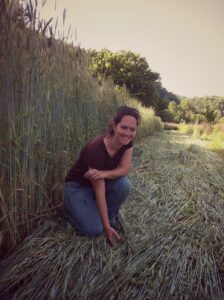2016 Annual Report for FS14-279
A comparison of organic no-till and traditional tillage/cultivation systems on a small-scale vegetable farm
Summary
A comparison of organic no-till and traditional tomato tillage/cultivation systems on a small-scale vegetable farm was conducted during the 2015 growing season at Riverbend Farm in Oneida, KY. 138 tomato plants were grown in a no-till system and 138 tomato plants were grown in a traditional tillage system. The traditional tillage system produced 120.35 more pounds and netted $201.30 more than the no-till system (after the difference in labor costs was assessed).
Objectives/Performance Targets
This project has two specific sub-goals:
- Measure potential yield differences between the organic no-till system and traditional tillage/cultivation practices;
- Calculate the economic implications of each production system by accounting for any observed yield differences and variations in labor hours.
Accomplishments/Milestones
Project design and methods:
- Crops tended with no-till practices were the experimental treatment, while crops grown with traditional establishment and cultivation served as controls.
- 138 tomato plants were transplanted in the experimental treatment, with an equal number transplanted into the control treatment. Thirteen varieties of tomatoes were planted, including a mix of hybrids, heirloom, and cherry tomatoes.
- Experimental plot preparation consisted of roller-crimping the existing cover crop, and control crop plot preparation consisted of plowing under existing cover crop.
- Both experimental and control crops were planted in the same field, right next to each other.
- All crop establishment and harvest activities occurred on the same day for both control and experimental crops.
- Crop yields (weight) and labor hours were tracked for both treatments throughout the growing season, and were assigned a monetary value at the end of the season. These data were used to compare the profitability of this organic no-till system using two-wheel tractor equipment to standard establishment and cultivation practices.
We intended to direct seed 500 row feet of winter squash in the experimental treatment, with an equal amount being direct-seeded into the control treatment. A Morrison no-till drill attachment for a walk behind tractor was purchased (before receiving the SARE grant) in order to plant winter squash seeds through the roller crimped cover crop residue. The winter squash seeds were planted with the no-till drill on May 25th, but the drill did not work correctly through the high residue created by the roller crimped rye and crimson clover. Since direct seeding into the residue was no longer an option, winter squash seeds were planted into flats during the last week of May to be transplanted through the residue four weeks later. June and July proved to be one of the wettest summers on record, preventing the conventional tillage plot from being re-prepared for planting in June. The winter squash trail ended up being abandoned after it became too late in the season to plant winter squash.
Impacts and Contributions/Outcomes
Harvests from the 2015 season are as follows: 260.74 lbs of tomatoes from the experimental plot and 381.09 lbs from the control plot. When these values are assigned a monetary amount equal to the price the tomatoes were sold at ($2/lb), the experimental plot grossed $521.48 and the control plot grossed $762.18.
Labor hours spent on the tomato trial during 2015 are as follows: 15.23 hours spent working in the experimental plot and 17.2 hours spent in the control plot. When these hours are assigned a monetary value of $20 per hour, the experimental treatment cost $304.60 in labor and the control treatment cost $344.
After accounting for the labor cost, the experimental plot netted $216.88 and the control plot netted $418.18. The experimental plot became quite weedy during the course of the season which may have contributed to the decreased yield compared to the control plot. It was impossible to pull the weeds up through the deep, roller crimped residue without disturbing the cover crop mulch layer. When the weeds were removed and the mulch layer disturbed it created more open ground for weeds to grow, so labor time was not spent pulling up weeds in the experimental plot.
